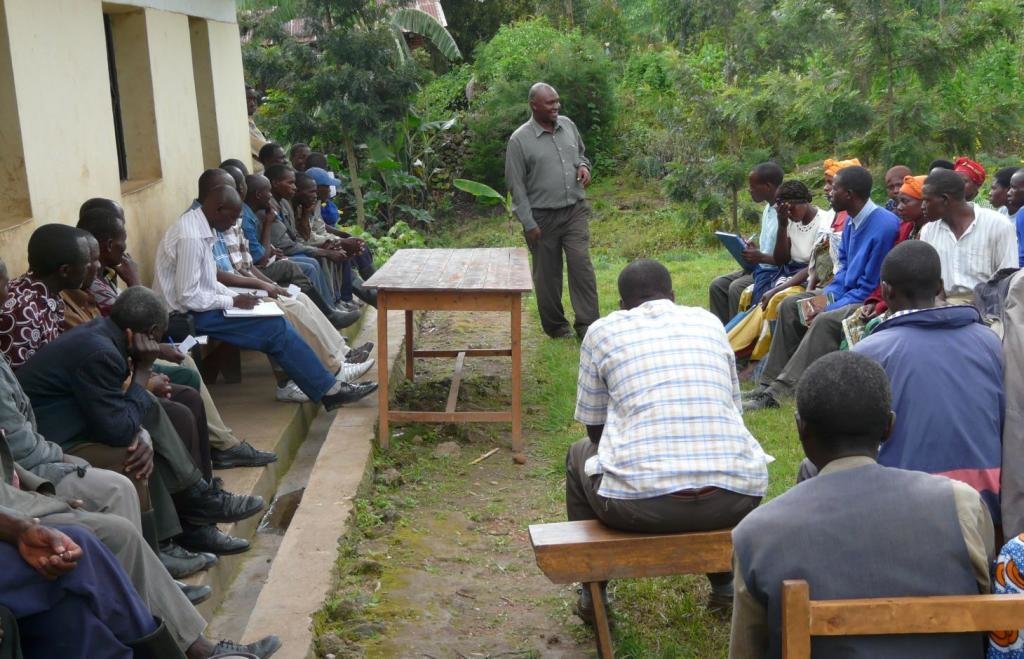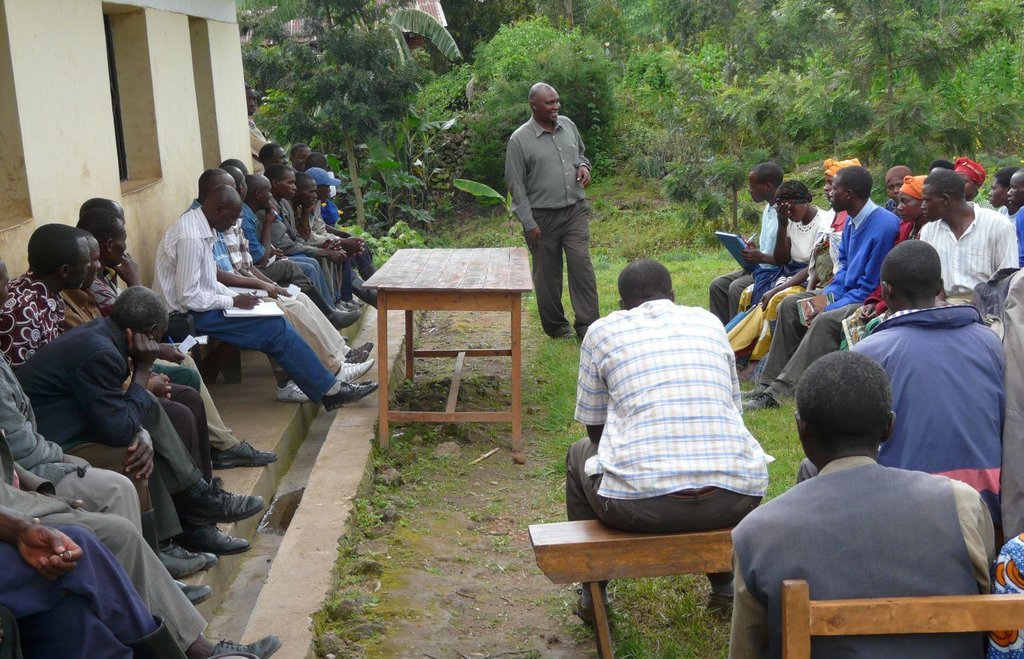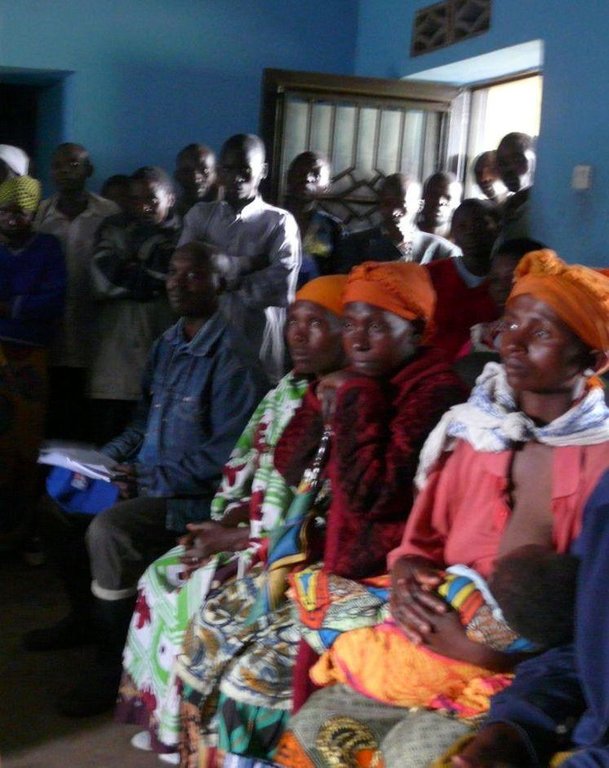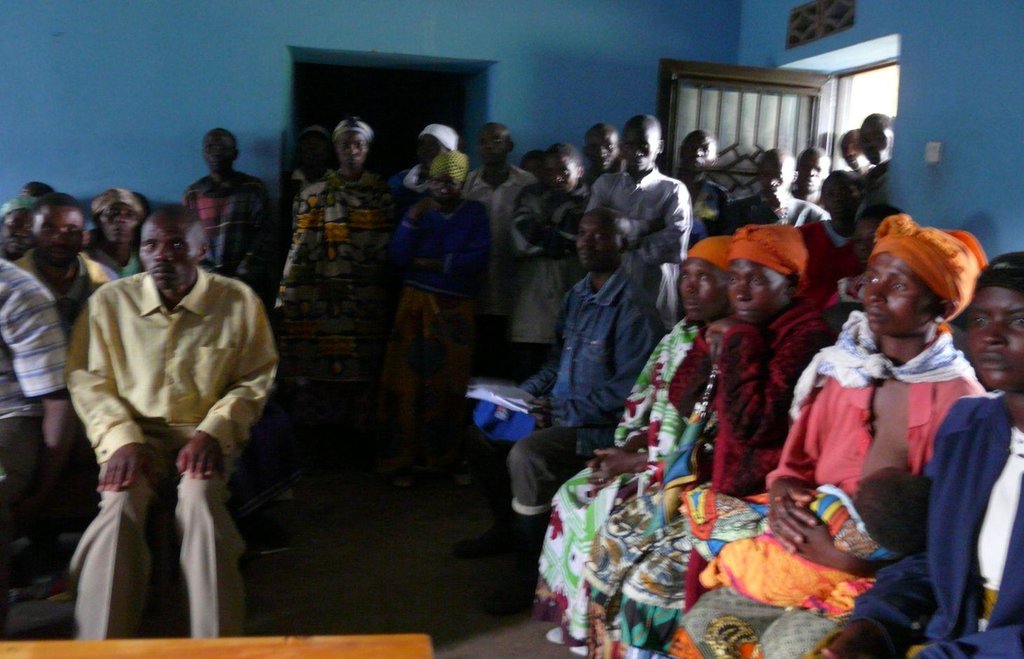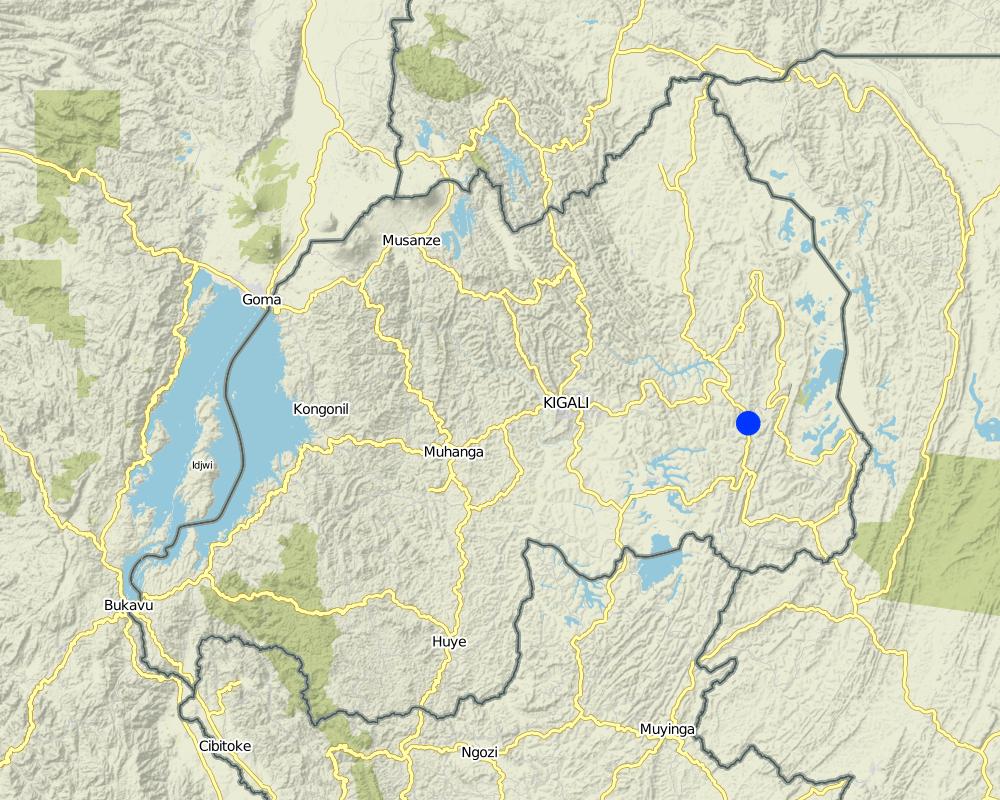Participatory approach [Rwanda]
- Création :
- Mise à jour :
- Compilateur : Desire Kagabo
- Rédacteur : –
- Examinateur : David Streiff
Ubufatanye bwinzego zose
approaches_2584 - Rwanda
Voir les sections
Développer tout Réduire tout1. Informations générales
1.2 Coordonnées des personnes-ressources et des institutions impliquées dans l'évaluation et la documentation de l'Approche
Spécialiste GDT:
Spécialiste GDT:
Muligirwa MULIGIRWAEmmanuel
Nom du projet qui a facilité la documentation/ l'évaluation de l'Approche (si pertinent)
The Transboundary Agro-ecosystem Management Project for the Kagera River Basin (GEF-FAO / Kagera TAMP )Nom du ou des institutions qui ont facilité la documentation/ l'évaluation de l'Approche (si pertinent)
Food and Agriculture Organization of the United Nations (FAO) - ItalieNom du ou des institutions qui ont facilité la documentation/ l'évaluation de l'Approche (si pertinent)
Rwanda Agriculture Board (Rwanda Agriculture Board) - Rwanda1.3 Conditions relatives à l'utilisation par WOCAT des données documentées
Quand les données ont-elles été compilées (sur le terrain)?
06/05/2014
Le compilateur et la(les) personne(s) ressource(s) acceptent les conditions relatives à l'utilisation par WOCAT des données documentées:
Oui
1.4 Références au(x) questionnaire(s) sur les Technologies de GDT
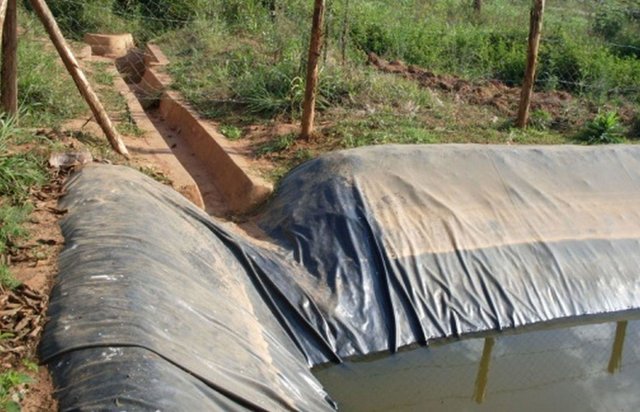
Lining geomembrane plastics for water harvesting and storage [Rwanda]
Lining geomembrane plastic for water harvesting and storage is a rainwater harvesting technique used by land users to collect rain water or runoff from a concave watershed to a common well-structured plastic-lined pond for agricultural, domestic and other use.
- Compilateur : Iwona Piechowiak
2. Description de l'Approche de GDT
2.1 Courte description de l'Approche
This approach is a contribution of different stakeholders and land users in the identification and resolution of a particular crop land problems, which implicate at the end different stage of intervention by all stakeholders to resolve the problem.
2.2 Description détaillée de l'Approche
Description détaillée de l'Approche:
Aims / objectives: The main goal of the approach is to plan and implement land management activities with villagers in such a way that sustainability is ensured. The specific objectives of the project are to:
(1) increase the capacity of the villagers to design, implement and self-evaluate Soil and water management activities.(2) improve crop production by limiting the effect of dry season during the critical stage of crop growth at the beginning of dry season.
Methods: This approach is integral to the Ministry of Agriculture and Animal Husbandry(MINAGRI) through a long-term project, which was initiated in 2005 and has been financed mainly by the government, with two different part of intervention of farmers which can be a voluntary participation and contributions of the local population or based on food for work.
Stages of implementation: Project extension work is carried out by facilitators from MINAGRI and consists of awareness raising and demonstration.
Problem identification and planning of activities takes place in village meetings. The local land users are supported by MINAGRI personnel who also provide technical and other facilities assistance during the implementation of Soil and Water Conservation measures
2.3 Photos de l'approche
2.5 Pays/ région/ lieux où l'Approche a été appliquée
Pays:
Rwanda
Région/ Etat/ Province:
East
Autres spécifications du lieu :
Kayonza
Commentaires:
The area is not well known it is approximately determined by land users and local authorities.
Map
×2.6 Dates de début et de fin de l'Approche
Indiquez l'année de démarrage:
2005
2.7 Type d'Approche
- local government, diferents stakeholders and land user.
2.8 Principaux objectifs de l'Approche
The Approach focused mainly on SLM with other activities (Reduce sedimentation and irrigation)
Design, test and disseminate alternative technologies adapted to local conditions - strengthen local knowledge of soil and water management measures.
The SLM Approach addressed the following problems: The lack of appropriate ways to develop sustainable technologies to remedy loss of runoff water and poor crop growth in the context of low-input agriculture on gentle undulating land in water scarce areas with an absence of soil conservation measures.
2.9 Conditions favorisant ou entravant la mise en œuvre de la(des) Technologie(s) appliquée(s) sous l'Approche
disponibilité/ accès aux ressources et services financiers
- entrave
Water harvesting is considered expensive due to material (mainly laying plastic sheet) and labour cost.
Treatment through the SLM Approach: Identification of a low-cost water harvesting measure, which can be implemented during the off-season. Cost-benefit analysis.
connaissances sur la GDT, accès aux supports techniques
- entrave
Difficulty in tilling the land when water harvesting structures are in place.
Treatment through the SLM Approach: Integrating new technologies and local knowledge of farmers about the market, into growing more profitable crops (cash crops).
3. Participation et rôles des parties prenantes impliquées dans l'Approche
3.1 Parties prenantes impliquées dans l'Approche et rôles
- exploitants locaux des terres / communautés locales
Decision making
- organisations communautaires
- Spécialistes de la GDT/ conseillers agricoles
- gouvernement local
- gouvernement national (planificateurs, décideurs)
- organisation internationale
3.2 Participation des exploitants locaux des terres/ communautés locales aux différentes phases de l'Approche
| Participation des exploitants locaux des terres/ communautés locales | Spécifiez qui était impliqué et décrivez les activités | |
|---|---|---|
| initiation/ motivation | interactive | |
| planification | interactive | |
| mise en œuvre | soutien extérieur | |
| suivi/ évaluation | interactive | |
| Research | interactive |
3.4 Prises de décision pour la sélection de la Technologie/ des Technologies
Indiquez qui a décidé de la sélection de la Technologie/ des Technologies à mettre en œuvre:
- principalement les spécialistes de la GDT, après consultation des exploitants des terres
Expliquez:
Decision were mad by land users and stakeholders.
Decisions on the method of implementing the SLM Technology were made by mainly by SLM specialists with consultation of land users
4. Soutien technique, renforcement des capacités et gestion des connaissances
4.1 Renforcement des capacités/ formation
Une formation a-t-elle été dispensée aux exploitants des terres/ autres parties prenantes?
Oui
Spécifiez qui a été formé:
- exploitants des terres
- personnels/ conseillers de terrain
Formats de la formation:
- zones de démonstration
4.2 Service de conseils
Les exploitants des terres ont-ils accès à un service de conseils?
Oui
Spécifiez si le service de conseils est fourni:
- dans les champs des exploitants?
Décrivez/ commentez:
Advisory service is quite adequate to ensure the continuation of land conservation activities; Land users are 100% willing to upscale the technology but they are financially not strong enough and unstable.
4.3 Renforcement des institutions (développement organisationnel)
Des institutions ont elles été mises en place ou renforcées par le biais de l'Approche?
- non
4.4 Suivi et évaluation
Le suivi et l'évaluation font ils partie de l'Approche? :
Oui
Commentaires:
bio-physical aspects were ad hoc monitored by government through observations
bio-physical aspects were regular monitored by government through measurements
technical aspects were ad hoc monitored by government through observations
technical aspects were regular monitored by government through measurements
socio-cultural aspects were ad hoc monitored by government and land users through observations
no. of land users involved aspects were regular monitored by government and land users through measurements
management of Approach aspects were regular monitored by government through observations
There were no changes in the Approach as a result of monitoring and evaluation
There were few changes in the Technology as a result of monitoring and evaluation: Land users are trying to organise themselves to implement the technology although it is expensive.
4.5 Recherche
La recherche a-t-elle fait partie intégrante de l’Approche?
Oui
Spécifiez les thèmes:
- sociologie
- économie/ marketing
- technologie
Donnez plus de détails et indiquez qui a mené ces recherches:
Research was carried out on-farm
5. Financement et soutien matériel externe
5.1 Budget annuel de la composante GDT de l'Approche
Si le budget annuel précis n'est pas connu, indiquez une fourchette:
- 10 000-100 000
Commentez (par ex. principales sources de financement/ principaux bailleurs de fonds):
Approach costs were met by the following donors: government: 40.0%; international non-government: 40.0%; local government (district, county, municipality, village etc): 15.0%; local community / land user(s): 5.0%
5.2 Soutiens financiers/ matériels fournis aux exploitants des terres
Les exploitants des terres ont-ils reçu un soutien financier/ matériel pour la mise en œuvre de la Technologie/ des Technologies?
Oui
Si oui, spécifiez le(s) type(s) de soutien, les conditions et les fournisseurs:
Care international provided funds (food for work) and the local government provided some equipments (plastic sheets) research staffs and means and training.
5.3 Subventions pour des intrants spécifiques (incluant la main d'œuvre)
- matériaux de construction
| Spécifiez les intrants subventionnés | Dans quelle mesure | Spécifiez les subventions |
|---|---|---|
| plastic sheets, ciment and fencing wires | entièrement financé | |
Si la main d'œuvre fournie par les exploitants des terres était un intrant substantiel, elle était:
- vivres-contre-travail
Commentaires:
Initial stage of implementation were funded by Care and the last stage were done voluntary (maintenance).
5.4 Crédits
Des crédits ont-ils été alloués à travers l'Approche pour les activités de GDT?
Non
6. Analyses d'impact et conclusions
6.1 Impacts de l'Approche
Est-ce que l'Approche a aidé les exploitants des terres à mettre en œuvre et entretenir les Technologies de GDT?
- Non
- Oui, un peu
- Oui, modérément
- Oui, beaucoup
Did other land users / projects adopt the Approach?
- Non
- Oui, un peu
- Oui, modérément
- Oui, beaucoup
Other land users around the technology adapted the technology in their land after being convinced by its importance.
Did the Approach lead to improved livelihoods / human well-being?
- Non
- Oui, un peu
- Oui, modérément
- Oui, beaucoup
Did the Approach help to alleviate poverty?
- Non
- Oui, un peu
- Oui, modérément
- Oui, beaucoup
6.2 Principale motivation des exploitants des terres pour mettre en œuvre la GDT
- augmenter la production
To increase crop production
- augmenter la rentabilité/ bénéfice, rapport coûts-bénéfices
To grow profitable crop like vegetables
- well-being and livelihoods improvement
Reduce povertty by increasing anual incom
6.3 Durabilité des activités de l'Approche
Les exploitants des terres peuvent-ils poursuivre ce qui a été mis en œuvre par le biais de l'Approche (sans soutien extérieur)?
- oui
Si oui, décrivez de quelle manière:
It has create good interaction between land users and other stakeholders.
6.4 Points forts/ avantages de l'Approche
| Points forts/ avantages/ possibilités du point de vue de l'exploitant des terres |
|---|
| Building of local knowledge (How to sustain/ enhance this strength: strengthen sensitization by the government) |
| Engagement of researchers with local innovators and thus interaction between scientific and indigenous knowledge (How to sustain/ enhance this strength: This approach can only be sustained if it is mainstreamed into national research and extension services.) |
| Points forts/ avantages/ possibilités du point de vue du compilateur ou d'une autre personne ressource clé |
|---|
| Capacity building of both land users and researchers (How to sustain/ enhance this strength: strengthen the interaction between SLM specialist and land uses by the government) |
6.5 Faiblesses/ inconvénients de l'Approche et moyens de les surmonter
| Faiblesses/ inconvénients/ risques du point de vue du compilateur ou d'une autre personne ressource clé | Comment peuvent-ils être surmontés? |
|---|---|
| Appropriate facilitating skills required | Mainstreaming facilitation skills. |
| Time demanding | Less time needed after the first steps of implementation |
7. Références et liens
7.1 Méthodes/ sources d'information
- visites de terrain, enquêtes sur le terrain
- interviews/entretiens avec les exploitants des terres
7.3 Liens vers les informations pertinentes disponibles en ligne
Titre/ description:
Kagera TAMP Project website
URL:
http://www.fao.org/in-action/kagera/home/en/
Liens et modules
Développer tout Réduire toutLiens

Lining geomembrane plastics for water harvesting and storage [Rwanda]
Lining geomembrane plastic for water harvesting and storage is a rainwater harvesting technique used by land users to collect rain water or runoff from a concave watershed to a common well-structured plastic-lined pond for agricultural, domestic and other use.
- Compilateur : Iwona Piechowiak
Modules
Aucun module trouvé



